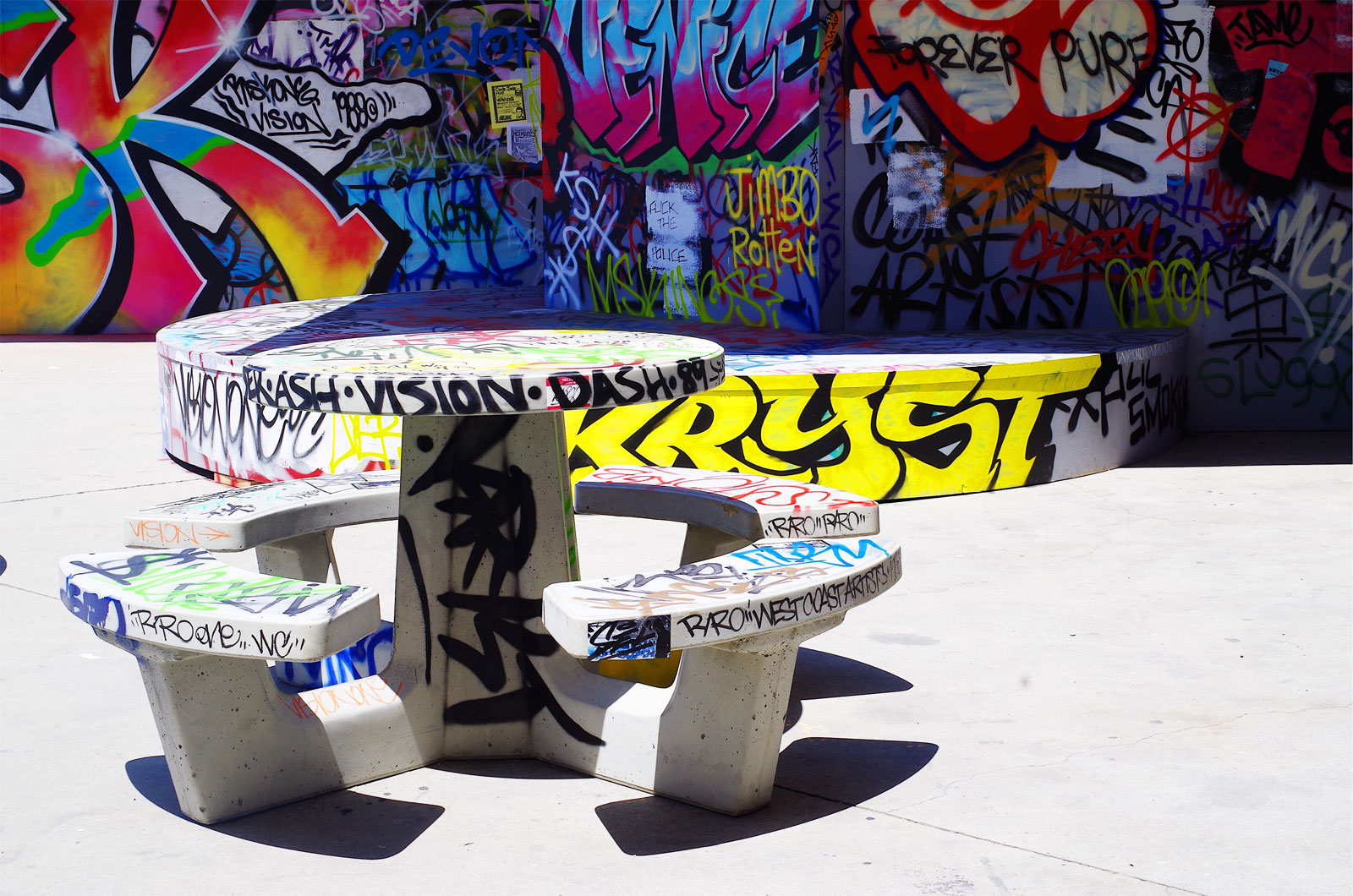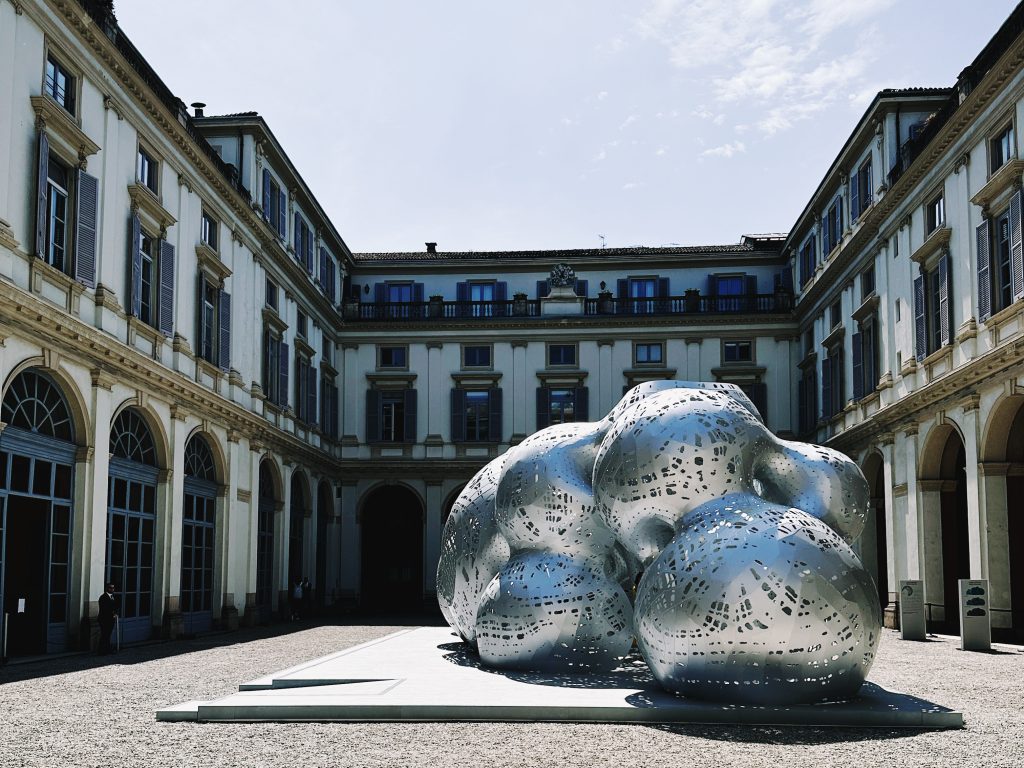RISK Recreates His Venice Pavilion Work for “Beyond The Streets”
A graffiti master invokes groundbreaking West Los Angeles iconography

by Kyle Raymond Fitzpatrick
One of the finest moments of the “Beyond The Streets” exhibition is a tagged seating area at the end of the show. Featuring concrete, circular park seats, paint-covered walls along with alien turrets scattered around, it’s a writer’s paradise that brings the show back to its West Coast street art roots. It serves as a reminder (or introduction) to the casual, quick, and illegal joy scribbling on a public surface.

In partnership with Beyond The Streets, adidas Skateboarding recreated the iconic Venice Pavilion, a former West Los Angeles recreation area built in the 1960s that became the home to skaters, artists, and locals alike. The venue was eventually torn down in the early 2000s after falling into ruins, but remains—even in memory—a cultural hub that helped shape what we now know to be street art and skate culture. Los Angeles artist RISK was tapped not only to recreate the work he made at the original pavilion in the late 1980s, but also to explore what the Pavilion—and graffiti in general—means today.
To better understand how RISK approached bringing this site back to life, we spoke with the artist about his process. Further, we talked with Cullen Poythress of adidas Action Sports to understand the motivation for the brand’s involvement.

What appealed to you in taking on the Pavilion at “Beyond The Streets” for a canvas? How is it different and or similar to other surfaces you’ve covered?
RISK: The Venice Pavilion was so important to West Coast graffiti that I wanted to make sure the OG writers were there for the recreation and painted the installation in the same spirit.
It is nothing like my current work and doesn’t even reflect my work from the last 10 to 15 years, but the Pavilion was where I spent the first decade years of my graffiti career, so I recreated a piece that I did 30 years ago. The original piece was done one night with scrap cans I got from earlier that day. Back then, graffiti was very illegal in the Pavilion so we would go to the local train tracks during the day and paint the trackside off the beaten path, and paint the Pavilion at night.

Painting—or bombing, to be more accurate—was something I was very familiar with in those days. We used whatever we had and covered as much space as possible. I was the first to do top to bottoms at the Pavilion and at many of the places and things I painted. It was my drive to paint bigger, and better on anything and everything.

How do you see the final product fit into your practice, at large?
RISK: I recreated a piece that I did 30 years ago, so it was like painting in reverse. The original piece was done before I had honed my painting skills so when recreating the piece, I had to literally tune out and paint with a loose random chaotic stroke, almost as if I was a drunk kid. This piece felt more like an art school assignment rather than an actual piece. It was more difficult to achieve than expected, but it was incredibly satisfying to take the trip down memory lane.

What was your process—and, as obvious as it sounds, motivation—for bringing this location back to life?
Cullen Poythress: The Venice Pavilion was the crossroads of so many important subcultures that existed in Southern California during the ’70s, ’80s, and ’90s. Historically, Venice is important not only for being the primary birthplace of street-style skateboarding but also because it was the common meeting point for so many different groups who collided there. Everyone influenced each other and coexisted in a way that had a major impact on the global skateboarding, surfing, art, music, and graffiti movements at the time. It was the local hang out spot for skaters, surfers, graffiti writers, artists, musicians, gangsters, punks, breakers, metalheads, and so many others.

What was it like working with RISK? What was the development process of envisioning a new Pavilion?
CP: RISK is one of the most prominent names in Los Angeles graffiti, making him the perfect partner to help adidas Skateboarding curate the reconstruction of the Pavilion. From the beginning, staying as true and authentic to every detail of the original site was a high priority for us. RISK and “Beyond The Streets” curator Roger Gastman played a huge role in helping us build out all of the true-to-size architectural elements and recruiting some of the OG writers from Venice to come and paint the installation. Having them painting the Pavilion together for the opening was something special to witness. We’re really proud of the Venice Pavilion installation and hope it pays the proper homage to this special and unique relic of the past.

How would you define Los Angeles graffiti art—past and present? What does it mean to be an LA graffiti artist today?
RISK: It’s very different now. Back then, we did it for ourselves. Nowadays, people do it for social media. Today, people are instant rockstars via social media, or they are just famous for the wrong reasons. Either way, it seems that the current art is not as thought out or conceptual to the context. It seems like everything now is about immediate gratification. That’s why we have the ever-so-popular street art. Street art involves the “work smarter, not harder” mentality, and graffiti is the old craftsman approach.
I don’t think anything is wrong with social media or street art. Overall, I think social media raised the bar tremendously, and I think street art elevated our generational art, whether it be street or graffiti art to the mainstream. However, it seems like there is a big divide among current graffiti artists—you are either a bomber trying to get up, or you are an artist working with galleries. It seems like we’re missing a lot of the overlap.
Original Venice Pavilion in 1989 image by RISK, all other images by Kyle Raymond Fitzpatrick












